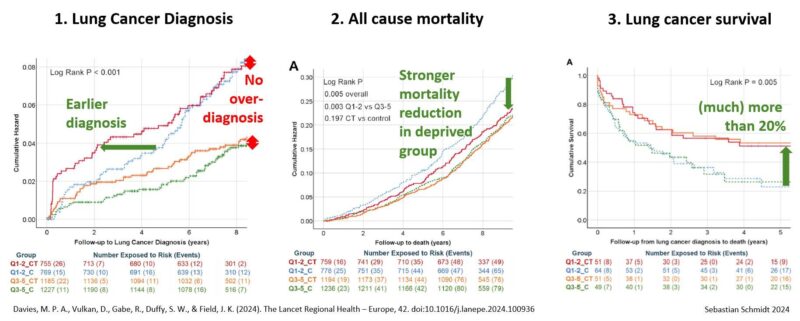Sebastian Schmidt shared a post on LinkedIn:
“More real-world evidence for lung cancer screening.
With the rapid roll-out of lung cancer screening programs globally we see more an more real-world evidence how well it works. This underlines the need to move forward with lung cancer screening.
One recent publication from Liverpool and London is especially remarkable. It gained a lot of attention for showing that lung cancer screening can mitigate the negative health effects of socio-economic deprivation.
But there is even more interesting data in the publication – I picked a few things that I found worth noticing, attached are graphs with my comments.
1. There is (again) no sign of overdiagnosis. As I explained in previous posts, if you plot the number of diagnosed lung cancers, overdiagnosis would appear as an upward shift (red). This is (again) not the case, so with long-enough follow-up, there is the same number of lung cancers found without screening, just later. No overdiagnosis. Zero.
The earlier diagnosis is clearly visible as a left-shift of the graph (green). Very good, one more confirmation.
Here the single-screen approach of UKLS is an advantage: We can clearly distinguish between left and upward shift of the curves. If you screening continuously, you couldn’t tell.
2. There is reduction of all-cause mortality in the deprived group. Given that the study was neither powered nor designed to measure all-cause mortality (small sample size, only a single CT exam), the expected result would be no visible effect, as we see in the higher-status groups (Q3-Q5, orange and green). However, we see a strong effect in the deprived group. Interestingly, the authors attribute this to improvements in COPD in the screened group – this is a positive effect that so far was not really seen in lung cancer screening studies. Given the limited sample size, this effect must be really strong – looking forward to seeing more on this.
3. My mantra: The mortality reduction of screening is much more than the often-cited 20% from NLST. See the survival curves of screen-detected versus non-screen detected lung cancers. You have to consider that the real effect with continuous screening is of course even more than here (single round of screening).”

Source: Sebastian Schmidt/LinkedIn
You can access previous posts by Sebastian Schmidt on OncoDaily.
